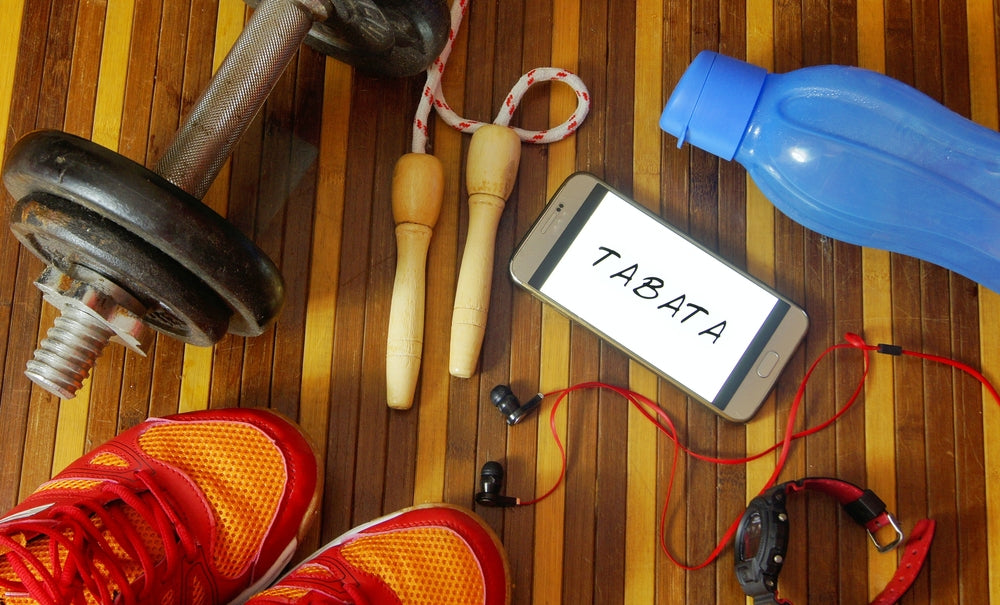Your cart is empty
Free shipping on all US orders


Free shipping on all orders

Imagine your fitness journey being a rollercoaster, with its highs and lows, twists and turns. In this adventure, Tabatas serve as those exhilarating loops, offering an intense experience with a lasting impact.
This form of High-Intensity Interval Training (HIIT) packs a punch in just four minutes, challenging your body and mind.
But how do you seamlessly incorporate Tabatas into your routine, and what makes them stand out from other workouts? Let's explore the mechanics and benefits, uncovering the potential to transform your fitness regime.
Fun Fact: Tabatas are named after a person.
The Tabata protocol originated in Japan in the late 1990s, crafted by scientist Dr. Izumi Tabata to enhance athletes' aerobic and anaerobic capacities. This innovative approach quickly gained traction, not only for its effectiveness but also as a representation of Japanese traditions in perseverance, discipline, and efficiency.

You'll find that Tabata's roots in Japan contribute significantly to its global popularity today. Its principles mirror the Japanese ethos of striving for improvement and excellence in all endeavors, making it more than just a workout—it's a testament to cultural resilience and innovation.
As it spread worldwide, Tabata became a symbol of how traditional values could adapt to serve contemporary needs, especially when it comes to athletic training and fitness evolution.
Its quick, intense bursts of exercise followed by short rest periods have revolutionized the way people think about fitness.
You no longer need to spend hours in the gym to achieve remarkable results. Today, Tabata's influence is undeniable.
Dr. Izumi Tabata's groundbreaking research revolutionized the fitness world by introducing a scientifically backed method to improve both aerobic and anaerobic capacity efficiently. His work began with a deep dive into training protocols comparison, shedding light on the Tabata protocol origins and its edge over traditional endurance workouts.
Dr. Tabata's initial study focused on high-intensity interval training (HIIT), where athletes performed short bursts of intense exercise followed by brief periods of rest.

What set Dr. Tabata's work apart was his meticulous observation of athletic performance impact. He discovered that athletes who followed his protocol not only boosted their aerobic capacity but also saw significant improvements in their anaerobic capacity.
This dual benefit was a game-changer, demonstrating that you don't need to spend hours in the gym to achieve comprehensive fitness results.
However, his research didn't escape scientific study critiques. Skeptics questioned the applicability of his findings to the general population, given that his original subjects were already highly trained athletes. Despite the debates, his work has continued to influence fitness enthusiasts worldwide.
One crucial aspect Dr. Tabata emphasized was the importance of recovery time recommendations. He advised adequate rest between sessions to prevent overtraining and maximize the benefits of the protocol. This insight ensures that you can safely incorporate Tabata into your fitness regimen, pushing your limits while safeguarding your health.
Before diving into the specifics of the Tabata protocol, it's essential you grasp the fundamentals of High-Intensity Interval Training (HIIT), a fitness approach that alternates short bursts of intense exercise with periods of rest or low-intensity activity.
Understanding the exercise physiology behind HIIT is crucial. It's about simultaneously maximizing your aerobic and anaerobic systems, pushing your body to improve its oxygen consumption and energy production capabilities.
You're not limited to one type of HIIT; there are various HIIT alternatives to suit different fitness levels and preferences. Whether it's sprinting, cycling, or bodyweight exercises, the key is to find an activity that allows you to safely push your limits during those intense intervals.
The beauty of HIIT lies in its versatility; minimal training equipment is needed. You can achieve a comprehensive workout with just your body weight or incorporate simple tools like dumbbells or resistance bands to add variety and challenge to your routine.
Recovery strategies play a pivotal role in HIIT. It's not just about focusing on the work you put in but also how well you recover. Incorporating adequate rest between intervals and employing techniques like stretching or foam rolling can enhance your performance metrics over time.
Speaking about performance metrics, tracking your progress is vital.
Monitoring improvements in your speed, endurance, and recovery times can motivate you and guide adjustments to your training intensity. This data-driven approach ensures you're not just working hard but also working smart, optimizing your HIIT sessions for maximum efficiency and effect.
Understanding the structure of a Tabata workout is necessary for maximizing its benefits, typically involving short, intense bursts of exercise followed by brief rest periods. A standard Tabata session lasts for just four minutes, broken down into eight cycles of 20 seconds of high-intensity effort followed by 10 seconds of rest.
This fast-paced routine demands focus and energy but don't worry; you won't need expensive equipment. Your body weight, dumbbells, or resistance bands can serve as your tools, offering various equipment options to keep your workouts fresh and challenging.

Before diving head first into a Tabata workout, it's vital to warm up. A five to ten-minute warm-up preps your muscles and cardiovascular system, reducing the risk of injury and ensuring you're ready to give it your all. Push yourself, but not to the point of harm.
Equally important is the recovery period after your workout. Your body needs time to repair and strengthen, so ensure you're allowing adequate rest between Tabata sessions. We don’t recommend you partake in Tabatas on a daily basis.
Progress tracking is also very helpful. Can you imagine mentally logging your workouts and even attempting to recall them? Keeping a record of your workouts helps you see improvements over time, whether it's managing more reps within the 20-second bursts or subjective feelings.
Tabatas can handsomely benefit your cardiovascular health, increasing heart efficiency and stamina. When you start this high-intensity interval training (HIIT) routine, you're not just pushing your limits; you're also embarking on a journey to better heart health.
By alternating between intense bursts of activity and brief recovery periods, you challenge your heart in a way that traditional workouts might not, promoting stronger, more efficient flow flow throughout your body.
This improved blood circulation plays a pivotal role in your overall well-being. It ensures that oxygen and nutrients are efficiently delivered to your tissues, supporting muscle repair and growth.
In addition, the quick shift from high to low intensity in Tabata workouts help reduce stress levels. As you focus on the exercise, your mind gets a break from daily worries, leading to stress reduction which, in turn, benefits your heart health.
Another often-overlooked advantage of Tabatas is their impact on recovery periods and sleep quality. Regular Tabata sessions can help regulate your body's internal clock, making it easier to fall asleep and stay asleep.
Better sleep quality is directly linked to lower stress levels and improved heart health, creating a positive feedback loop that enhances your overall cardiovascular condition.
While boosting your cardiovascular health, engaging in Tabatas also ramps up your metabolic rate, offering another layer of benefits. This increase in metabolic rate isn't just a temporary boost; it's a long lasting change that can significantly impact your body's ability to burn calories more efficiently, even when you're at rest.
Add Lean to your supplement regimen for an even greater metabolic boost as you incinerate calories all day long.
The dietary impact of a higher metabolic rate are noteworthy. You'll find that your body can better handle the foods you eat, utilizing nutrients more efficiently and even allowing for a more flexible diet. However, it's vital to choose nutritious foods that support your workout regime and overall health goals.
As your body becomes more efficient at managing energy and recovery, you'll likely experience less physical stress, which can also lead to improved mental health. This can create a positive feedback loop, where reduced stress contributes to better sleep quality, further enhancing your metabolic rate and overall well-being.
Age considerations play an important role in dictating how Tabatas affect metabolic rate. While younger individuals may see rapid increases, older adults can also benefit significantly. It's all about adapting the intensity to match your fitness level and focusing on recovery strategies to maximize the benefits.
Adequate rest, hydration, and nutrient-rich foods are key components that allow you to sustain a higher metabolic rate and ensure that your fitness journey is both effective and enjoyable.
Performing Tabatas can help boost your muscle endurance, allowing you to perform longer and at higher intensities without tiring. This intense form of workout pushes your muscles to adapt, enhancing their ability to sustain effort over extended periods- even though the workout iutself is very brief.
To maximize these benefits, you'll need to pay close attention to your nutrition. Including protein-rich foods in your diet supports muscle repair and growth, and is helpful for endurance. Carbohydrates are also essential, providing the energy your muscles need to power through a session. Adding a creatine based formula such as Foundation can help provide the explosive power you need for tabatas, while also improving ATP re-generation, aided by the inclusion of peak ATP.
Recovery strategies play a vital role in improving muscle endurance. Adequate rest between sessions prevents overtraining and allows muscles to become stronger. Incorporating active recovery, like light cardio or stretching, can further enhance this process.
To continuously challenge your muscles and increase endurance, progressive overload is key. Gradually increasing the intensity, volume, or even the duration of your Tabatas ensures ongoing improvements. This might mean adding more cycles, upping the pace, or incorporating weights as you progress.
Monitoring your progress against strength benchmarks can motivate you and provide tangible evidence of your increasing endurance. These benchmarks vary but could include longer plank times, increased repetitions of bodyweight exercises, or lifting heavier weights.
One of the most compelling and desirable benefits of high-intensity interval training is its ability to maximize fat loss efficiently. When you dive into Tabatas, you're not just challenging your muscles; you're setting the stage for your body to burn fat more effectively even when you're not sweating it out. However, to really capitalize on this fat loss, you've got to pay attention to more than just your workout routine.
Dietary considerations play a huge role here. You can't out-train a bad diet. Fueling your body with the right nutrients ensures that you're building muscle and shedding fat, not the other way around. Pairing Tabatas with a balanced diet amplifies your fat loss results, making each session count even more.
Sleep is another thing, as emphasized before. It's during those Zs that your body recovers, repairs, and prepares itself for the next day. Poor sleep can sabotage your fat loss efforts by messing with your hormones, so ensure you're getting enough rest. If you just can’t, try a safe non-habit forming supplement like Dreamzzz to get you back on track.
Lastly, stress management is crucial. High stress levels can lead to fat retention, especially around the midsection. Incorporating stress-reducing practices can complement your physical efforts, rounding out your approach to maximizing fat loss with Tabatas.
Beyond physical fitness and fat loss, Tabatas also significantly bolster your mental resilience and toughness. This high-intensity interval training pushes you to your limits, not just physically, but mentally as well, enhancing your mental resilience.
The short bursts of intense exercise followed by only brief rest periods require you to dig deep and find that inner strength, teaching you to endure discomfort and push through barriers you thought were impossible to overcome.
As such, its not surprising when you hear that Tabatas also play a crucial role in stress coping. The intense physical activity helps in releasing endorphins, the body's natural mood enhancers, which in turn assist in managing stress levels even more effectively. You'll find that the regular utilization of Tabatas can lead to a more balanced emotional state, helping you navigate life's ups and downs with greater ease.
On top of this, the focus enhancement you gain from sticking to the rigorous Tabata schedule is undeniable. Each session demands your full attention—there's no room for your mind to wander when you're counting down those last few seconds of a sprint or squat. This heightened focus during workouts translates to improved concentration in other areas of your life, making you more productive and efficient.
So, overall the psychological benefits of completing a challenging Tabata workout are immense. Every session you complete builds not just physical strength but also reinforces your belief in your ability to tackle challenges, fostering emotional strength. The sense of accomplishment after finishing a particularly tough workout can boost your confidence and resilience, equipping you better for life's challenges.
Tabatas actually stand out for their adaptability and diversity, allowing you to mix and match exercises to fit your unique fitness goals and preferences. This level of flexibility is hard to find in other workout routines.
With a wide range of equipment options, you're not limited to a gym setting. You can easily adapt Tabatas to use bodyweight exercises, resistance bands, or whatever tools you have at hand, making it possible to keep your workouts fresh and engaging anywhere—be it at home, in the park, or while traveling.
Choice of workout locations are just as flexible. You don't need a lot of space, so whether you're in a cramped apartment or a sprawling backyard, you can still get a full, intense workout in. This versatility extends to age adaptability too, with exercises that can be modified to suit any fitness level, ensuring everyone from beginners to the elderly can safely participate and benefit.
There is scarcely a reason to not include more Tabatas- but we do recommend you speak to a professional if you have a pre-existing health condition or are in poor physical shape that makes exercise difficult.
Incorporating Tabatas into your fitness routine can significantly cut down on your workout time without sacrificing results. Would you rather perform a mind-numbing 60-90 minutes on the treadmill, or a mind-boggling 4 minutes doing tabatas? We think we know the answer.
Tabatas are a godsend for those juggling busy lifestyles. You're always looking for efficient workouts that fit into your hectic schedule, and Tabatas deliver just that. Each session lasts only four minutes, but don't be fooled; these quick exercises pack a punch, offering you an intense workout that's hard to match with longer, less focused sessions.

Time management becomes a breeze with Tabatas. Instead of spending hours at the gym, you can allocate just a few minutes to your workout and still achieve or even surpass your fitness goals. This efficiency makes Tabatas an ideal choice for anyone who feels there aren't enough hours in the day for traditional exercise routines.
Plus the minimal equipment required for Tabatas means you can perform these exercises almost anywhere, further saving you time. There's no need to commute to the gym or wait for machines to free up. Whether you're at home, in a hotel room, or in a small space, you can engage in this powerful workout.
Starting to integrate Tabatas in your daily routine can seem daunting, but it's actually quite straightforward and can be done with minimal disruption to your existing schedule. First off, choosing equipment doesn't have to be a hassle.
You'll need minimal gear—if any at all. Bodyweight exercises like squats, push-ups, and burpees are perfect for Tabatas, making it easy to start without investing and arm and a leg into expensive equipment.
We recommend music to keep the pace up. Fast-paced beats that match the intensity of the Tabata intervals can help you push harder and stay on beat during those challenging 20-second bursts of effort.
Keeping water handy is crucial, especially since Tabatas are high-intensity and can make you sweat a lot. Drink water before, during, and after your workout to stay hydrated and prevent performance impairing dehydration.
Last, but not least, give your body the rest it needs between sessions. Tabatas are intense- basically equivalent to weightlifting sessions, so ensure you have at least one day of rest or light activity between these workouts to allow your muscles to recover and grow stronger.
Tabatas can be a real game-changer if you take the time to do them appropriately, and stick with them for a period of time. You’ll be shellshocked to see how much you can achieve with so little.
But remember- it's all about pushing your limits in bursts of intense effort. Give it a try and watch yourself transform.